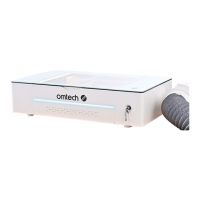19
4.3 Rotary Operation Instructions
The Polar 350 comes with two separate 4-wheel rotary axis devices to engrave round and cylindrical surfaces.
Use Rotary Axis 1 for larger items and use 2 for smaller ones.
Step 1 Create your design that you'd like to engrave. You can do this directly in your engraving software or
use any other graphics program.
Step 2 Remove the debris tray and the honeycomb workbed. Set them aside where they will not be
damaged or fall over. Gently move the laser tube and X-axis rail forward. Use the nearby bracket to
hold the tray interlock switch closed.
Step 3 Flip both rotary switches up towards the back of the main bay to deactivate the Y axis motors and
control signals and activate the rotary aviation socket.
Step 4 Uncover the rotary aviation socket and connect one of the rotary cables. You will need to pull back
its outer sheath while aligning the 4 holes to their pins. Connect the other end of the cable to the
motor of the rotary you will be using.
Step 5 Place your rotary axis in the open bay so that its number label is in the front left corner and its
support frame is flush with the left side of the open bay.
Step 6 Gently move the laser tube and X-axis rail back so that its arrow label is properly aligned.
When you are using Rotary Axis 1, align the 1 arrow label on the laser tube casing with the arrow
label on the RIGHT side of the bay.
When you are using Rotary Axis 2, align the 2 arrow label on the laser tube casing with the arrow
label on the LEFT side of the bay.
Step 7 Place your object carefully onto the rotary axis and measure the distance from the upper surface of
the rotary base to the upper surface of your object. The Offset value for the 2-inch focus lens will
be 86.2 minus this distance in mm.
Follow the other steps as with regular engraving. When you are finished, remember to reenable the tray
interlock.
4.4 Instructions for Specific Materials
The following instructions are suggestions to help speed safe work with a range of materials. The user
should research the specific safety and engraving requirements of their specific material to avoid the risk
of fire, hazardous dust, corrosive and poisonous fumes, and other potential problems. Once the product is
known to be safe or appropriate protective equipment has been set up, it can be helpful to engrave a test
matrix of small boxes produced at various speed and power settings to discover the ideal settings for your
design. Alternatively, start with low power and fast speed settings and rerun your design as many times as
needed, using progressively greater laser intensity.
Average Engraving Settings
Material Acrylic Basswood Canvas Cardboard Leather MDF Rubber
Engraving
Power
(W)
25 25 12.5 22.5 15 20 17.5
50% 50% 25% 45% 30% 40% 35%
Speed
(mm/s)
500 500 500 500 500 500 500
100% 100% 100% 100% 100% 100% 100%
Cutting
Power
(W)
45 45 30 45 45 45 N/A
90% 90% 60% 90% 90% 90% N/A
Speed
(mm/s)
35 65 350 200 80 30 N/A
7% 13% 70% 40% 16% 6% N/A
Rec. Thickness
(mm)
3 3 0.2 2 1.5 3 3
Resolution
(dpi)
400 400 300 400 400 300 400

